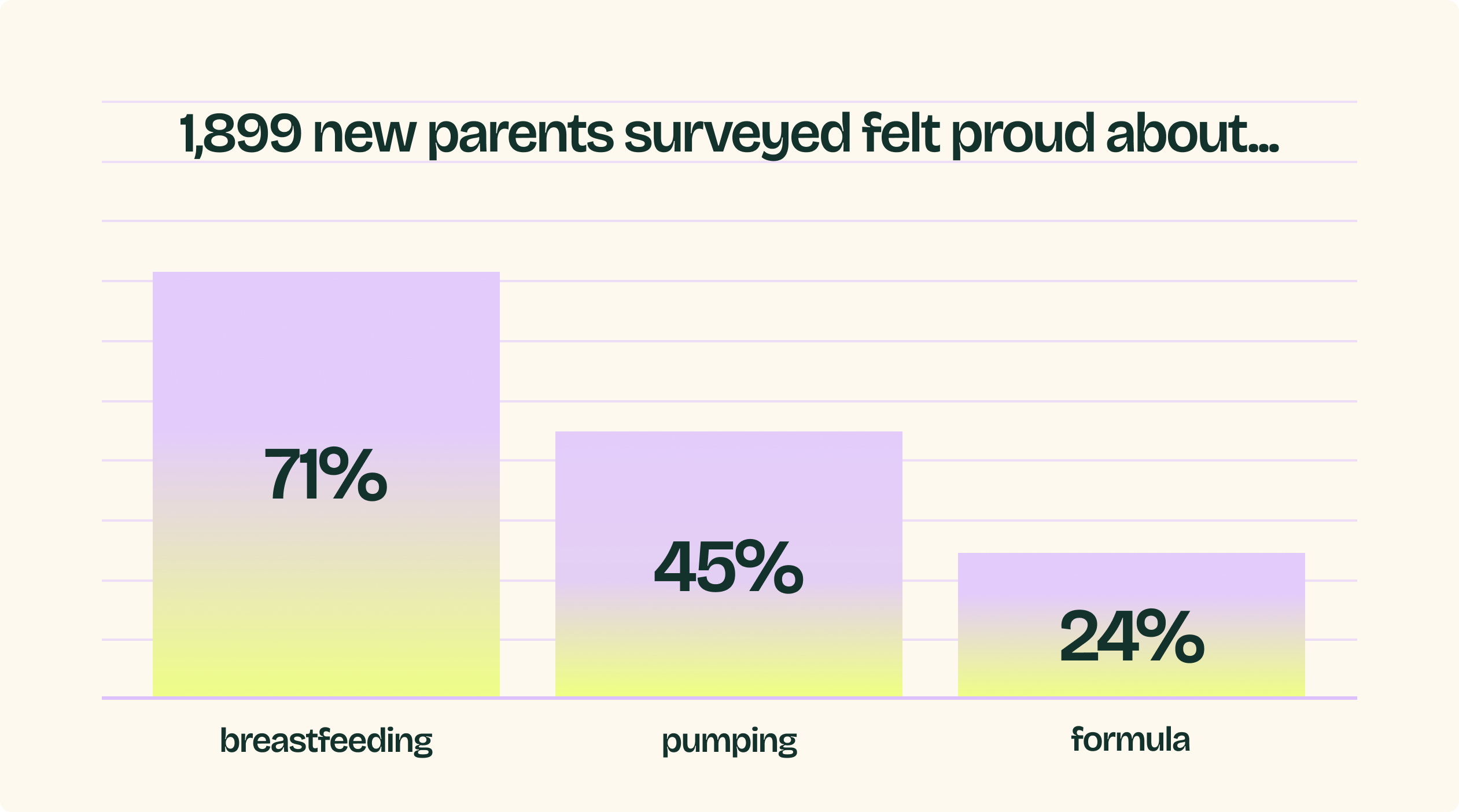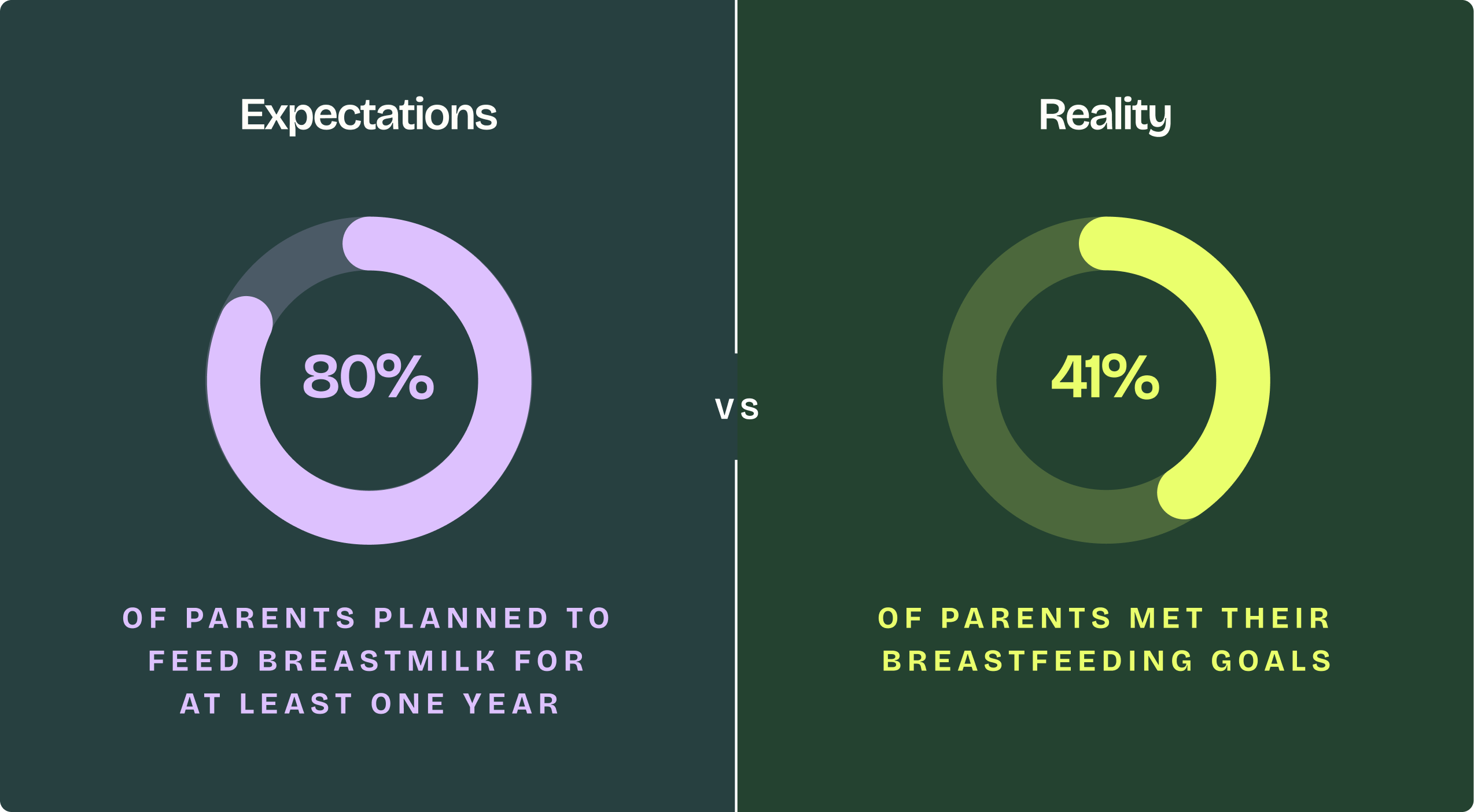The feeding culture in America has changed radically in recent years, and it's time for the conversation to catch up. Our three brands have unique insight into the day-to-day realities of what feeding actually looks like today. By coming together, Bobbie and Willow are showcasing the State of Feeding to redefine expectations and better equip parents for the journey ahead.
Enter: Professor Emily Oster, Bobbie MotherBoard member, Economist, and mom of two. Below, she gives her expert analysis of the top-level findings from our survey, to bring you the need-to-know data of what it looks like to feed babies in America today.
When my daughter was born, my milk took a long time to come in. In the interim, I used a combination of bottles of formula and a complicated setup called a “supplemental nursing system,” while also nursing her for the colostrum. When I did have more milk we continued to supplement with some formula, and I pumped - at home to build a supply, and at work when I went back. For at least the first six months of her life, she had milk from the breast, pumped milk and formula nearly every day.
I make my living thinking about and writing about data, and data on breastfeeding typically comes from surveys where we ask people a simple question: Did you breastfeed your child or not? This simple binary leaves so much unsaid. What would I even answer? I did breastfeed, but not exclusively. When I talk to other women about this, sometimes they will ask me: Does pumping count for answering that question?
“The data is binary, but experiences are complex. When we do not surface that complexity, it does a disservice to people who are in the middle of these experiences.”
In an effort to fill in this gap, I partnered with Bobbie and Willow to survey 1,899 new parents who have had a baby in the last year. The survey drew on customer data from each company, and the picture it paints is one that is much richer and more varied than could be summarized in a simple “breastfed or not” binary.
The Emotions of Feeding
The emotional response to feeding methods highlights how expectations, societal pressures, and reality collide. How we feed our babies is among the most emotionally fraught parts of early parenting. I remember very vividly the feeling of, honestly, failure when my very specific breastfeeding plans did not pan out as I imagined. When I reflect on that now, at the moment when the child in question is almost a teenager, it's hard to believe how much emotional weight I put on this one parenting activity. And, yet, I did. And we do, too.
In the data, how parents feel about their feeding choices strongly relates to what those choices are. 71% of parents feel proud about breastfeeding, versus 45% feeling proud about pumping, and 24% for formula.

the takeaway:
These numbers should be 100% for everyone! We should all feel proud of how we are nourishing our children. The fact that they are not 100% for any group tells us we have work to do to make sure all parents feel supported, confident, and happy in the choices they make.
Feeding Expectations Versus Reality
Anyone who has fed a child can attest to how rife that experience is with suggestions, opinions and 'you shoulds'. Whether that's from a well-intentioned friend or a healthcare professional, these recommendations ultimately inform our feeding goals. Like, for example, the AAP who recommend exclusive breastfeeding for 6 months and continued breastfeeding to 2 years and beyond.
“The truth, as we found, is that most feeding realities do not align with expectations. And that's okay.”
We asked current and expecting parents about how they intended to feed their babies, 98% of them had a plan! These feeding plans vary widely, and fall into 3 main categories: 25% of respondents reported they planned to exclusively breastfeed, 55% planned to both breastfeed and pump, 11% planned to combine breastfeeding, pumping and formula.
The Expectation: 80% of moms intend to exclusively feed breastmilk, with most intending to do so for 12 months.
The Reality: The average mom makes it to 6 months with 25% exclusively feeding breastmilk. Contrary to expectations, 87% of moms end up pumping and 74% using formula. 87% of respondents are using a variation of breastfeeding, pumping and formula.

the takeaway:
Few parents surveyed plan to breastfeed for two years (per the most recent AAP recommendation) - the majority (80%) plan to feed breastmilk (by breastfeeding and/ or pumping) for at least one year. In our survey data, only 41% of parents met their breastfeeding goals. The AAP's guidance to increase breastfeeding to 2 years seems out of reach for most.
Combination Feeding
Enter combo feeding: feeding with any combination of breastmilk (breastfeeding and/or pumping) and formula. The bottom line is that combo feeding is extremely common among people who meet their breastfeeding goals.
Of the women in the survey who met their breastfeeding goal, 61% of them incorporated combo feeding into their feeding journey.
What this tells us - crucially - is that combination feeding isn't a barrier to breastfeeding success. Women can meet (or exceed!) their breastfeeding goals while also incorporating pumping and/or formula into their feeding journey.
the takeaway:
Combo feeding (some combination of breast milk and formula) extends the majority of parents' breastfeeding journeys (for those who rely on it as a feeding choice). This is a clear reminder that when it comes to feeding, it's not an either/or, but rather a spectrum of choices.
Provider Support
Whether you're breastfeeding, pumping, formula feeding or a combination of all three, our survey found that the support you get from your healthcare provider varies greatly. Almost half of respondents - 47% - reported receiving no support or education around formula feeding, and 38% received no support on pumping. 82% of people receive some type of support and education around breastfeeding throughout their breastfeeding experience.
We asked about the reasons parents stop breastfeeding, and learned that 80% stop breastfeeding because of issues outside of their control. The majority of reasons focused on issues with lactation or supply, concerns about infant nutrition & weight, lack of parental leave and supportive work policies and lack of lactation support.
the takeaway:
This survey has identified a clear gap in support when it comes to all feeding types, no matter what feeding goals look like. There is a clear need for additional educational support around all feeding types, and societal support around maintaining supply.
Conclusion
When I was up at 3am, nursing, then pumping, then supplementing - it was hard not to feel very alone. I wish I had known just how common this was. I wasn't just not alone, my experience was the norm. To provide the best support and connection to new parents, we need to show them that what they are going through is not a unique challenge. That, in fact, they are surrounded by new parents feeling the exact same things. My view is that data can do this - with the right data tools, we can show people their community. And we can drive more support for every choice.
It is clear that parents need more support and education across the board when it comes to feeding. We've all experienced that the systems are broken - we must create societal infrastructure that will meaningfully support parents throughout their feeding journey, regardless of their method. As three women-led companies entrenched in the feeding space, we know that our greatest potential for impact lies in supporting our parents. That's why we created our collaborative Feeding Guide. We hope that no matter where you find yourself in your feeding journey, it leaves you feeling supported, educated, and empowered - whether you're using breast, bottle, pump or all three.

